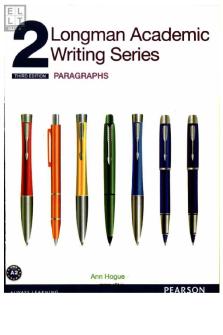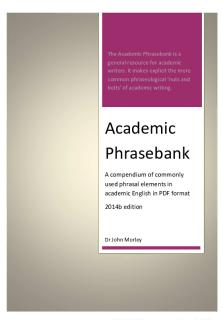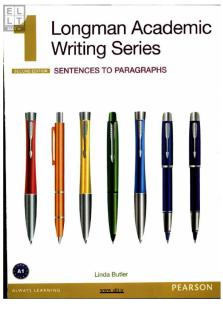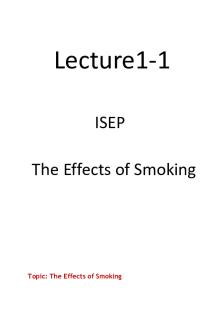Longman Academic Writing Series 5 (Teacher’s Manual) PDF

| Title | Longman Academic Writing Series 5 (Teacher’s Manual) |
|---|---|
| Author | hoomaan alaeiyan |
| Course | non destructive testing |
| Institution | دانشگاه تهران |
| Pages | 85 |
| File Size | 1.3 MB |
| File Type | |
| Total Downloads | 15 |
| Total Views | 320 |
Summary
srgregergr rgregre...
Description
5
Longman Academic Writing Series ESSAYS TO RESEARCH PAPERS
Teacher’s Manual
Alan Meyers with contributions from Lindsey Rothschild Educational Technology Consultant
Longman Academic Writing Series 5: Essays to Research Papers Teacher’s Manual Copyright © 2014 by Pearson Education, Inc. All rights reserved.
No part of this publication may be reproduced, stored in a retrieval system, or transmitted in any form or by any means, electronic, mechanical, photocopying, recording, or otherwise, without the prior permission of the publisher. Pearson Education, 10 Bank Street, White Plains, NY 10606
Staff Credits: The people who made up the Longman Academic Writing Series 5 Teacher’s Manual team, representing editorial, production, design, and manufacturing, are Eleanor Barnes, Shelley Gazes, Amy McCormick, Lise Minovitz, Liza Pleva, and JoanPoole.
Text Composition: TSI Graphics
ISBN-10: 0-13-291275-9 ISBN-13: 978-0-13-291275-4
CONTENTS Introduction ....................................................................................... iv General Teaching Notes ...................................................................... 1 Chapter Teaching Notes ...................................................................... 9 Chapter 1 Notes ............................................................................................... 10 Chapter 2 Notes ............................................................................................... 13 Chapter 3 Notes ............................................................................................... 16 Chapter 4 Notes ............................................................................................... 19 Chapter 5 Notes ............................................................................................... 22 Chapter 6 Notes ............................................................................................... 25 Chapter 7 Notes ............................................................................................... 28 Chapter 8 Notes ............................................................................................... 31 Chapter 9 Notes ............................................................................................... 34
Writing Assignment Scoring Rubrics ............................................... 38 Chapter Quizzes ................................................................................ 48 Chapter Quiz Answer Key ................................................................ 65
© 2014 by Pearson Education, Inc.
Student Book Answer Key ............................................................... 69
Longman Academic Writing Series 5, Teacher’s Manual
●
Contents
iii
INTRODUCTION Welcome to Level 5 in the Longman Academic Writing Series, a fi ve-level series that prepares English language learners for academic coursework. This book is intended for advanced students in university, college, or secondary school programs who need to write longer essays and research papers. It offers a carefully structured approach that focuses on writing as a process. It teaches rhetoric and sentence structure in a straightforward manner, using a step-by-step approach, high-interest models, and varied practice types. It also addresses the writing, research, and documentation of papers in different academic areas. Each chapter explores a different rhetorical genre—classifi cation, process, cause / effect, definition, summary / response, argumentation, and the research paper—as it applies to academic writing across the curriculum. As in the other titles in this series, this book integrates instruction in organization and sentence structure with the writing process. It carefully guides students through the steps of the writing process to produce the well-organized, clearly developed essays and term papers that are essential to academic writing in English. You will find a wealth of realistic models to guide writers and clear explanations supported by examples that will help your students through typical rough spots. These explanations are followed by the extensive practice that learners need to assimilate writing skills and write with accuracy and confidence. Interactive tasks, including pair work, group work, and full-class discussions, engage students in the learning process and complement the solitary work that writers must do. The tasks progress from recognition exercises to controlled production, and culminate in the chapter Writing Assignments. The extensive appendices and a thorough index make the text a valuable and easy-to-use reference tool.
Features Instructors will fi nd these essential features to enable students to move through the course with confi dence: • Theme-based chapters focus on a particular academic area and rhetorical genre. • Chapter objectives provide clear goals for instruction. • Realistic writing models with academic content present the type of writing students will learn to produce in the end-of-chapter Writing Assignments. • Two vocabulary sections, Noticing Vocabulary and Applying Vocabulary, highlight useful words and phrases from the writing models and allow students to practice the new vocabulary and use it in their writing assignments. • Organization sections explore the structure of papers in a variety of organizational patterns. • Sections on Grammar and Sentence Structure provide practice with the structures that pose the most difficulties for advanced students.
• Step-by-step Writing Assignments make the writing process clear and easy to follow. • Timed Writing practice develops students’ writing fl uency. • Writing Guides for each rhetorical genre give students the tools they need to improve the flow of ideas in their papers. • Citation guidelines on MLA and APA formats provide students with the documentation skills needed to write papers for a variety of academic fi elds.
Longman Academic Writing Series 5, Teacher’s Manual
●
Introduction
iv
© 2014 by Pearson Education, Inc.
• A Preparation for Writing section reinforces learning and develops the research and documentation skills needed for the writing assignment.
The Teacher’s Manual This Teacher’s Manual includes information and suggestions to help you teach this course. Itincludes these features: • General Teaching Notes explain how to use the Student Book effectively. • Chapter Teaching Notes provide step-by-step instructions on how to teach each section, as well as variations and expansions for the practice activities. • Writing Assignment Scoring Rubrics facilitate fair and easy grading. They can be photocopied and used for all students in the class. • Chapter Quizzes assess students’ writing and editing skills. They can be photocopied and used for all students in the class. An answer key for the quizzes is also provided.
© 2014 by Pearson Education, Inc.
• The Student Book Answer Key provides answers for all Student Book practice activities.
Longman Academic Writing Series 5, Teacher’s Manual
●
Introduction
v
GENERAL TEACHING NOTES
1
GENERAL TEACHING NOTES These notes describe the chapter organization in the Student Book and provide general suggestions on how to approach each section. They also include information about the Writing Assignment Scoring Rubrics and Chapter Quizzes in this manual, as well as suggestions on how to integrate technology, a brief description of MyCompLab (www.mycomplab.com for additional writing skill practice, composition practice, and assessments), and procedures for teachers interested in having students keep portfolios of their work. Step-by-step teaching suggestions for the Student Book are in the Chapter Teaching Notes that follow.
Student Book The book contains nine chapters, each one organized as follows.
Chapter Opener This page includes the chapter title, a photo, and a list of objectives. The chapter title and photo provide an opportunity for students to express ideas about the chapter theme, exercise their imaginations, and share their experiences. The photo is thematically related to the writing model in the next section. The objectives preview the chapter writing skills and provide a roadmap for teachers and students. You may want to spend 10 to 15 minutes on this page.
Introduction The introduction includes a brief presentation of the elements of academic writing or the genre that is the focus of the chapter. This section has the following additional components.
Writing Model Each chapter presents one or two writing models. These provide appropriate models for the chapter’s writing assignment. The models are followed by questions that help students notice the important structure (including, for example, questions on thesis statements and topic sentences, types of supporting information, the role of individual paragraphs, and transitional devices), content (with comprehension, inference, and opinion questions), and language displayed in the models. You may want to add your own questions and have students analyze the writing modelsfurther.
!Noticing Vocabulary
Skill-Building: Organization The organization section highlights increasingly more complicated rhetorical modes (classifi cation, process essay, cause / effect analysis, definition, problem / solution, summary/ response, and argument), culminating with the research paper. Each organization mode is graphically represented and refers back to the models. Included are lists of key transitional words and expressions, as well as a reference to the fill-in-the-blank guides found in Appendix A, pages189–194.
Longman Academic Writing Series 5, Teacher’s Manual
●
General Teaching Notes
2
© 2014 by Pearson Education, Inc.
This section highlights, explains, and provides practice with useful words and phrases from the models. Types of vocabulary include negative prefi xes with adjectives, collocations, irregular plurals from Latin and Greek, phrasal verbs, synonyms, adverbial intensifiers, and antonyms.
Skill Building: Grammar or Sentence Structure The grammar and sentence structure sections focus on sentence structure, grammar, mechanics, or a combination of these skills. Brief explanations and clear charts help students understand and apply these skills. Carefully sequenced practice activities reinforce this information in a controlled way, and Try It Out! activities provide opportunities to apply the skills in a more creative way. A complete Answer Key for all practice activities is on pages 69–80 of this manual.
Practice Activities for Organization and Sentence Structure Practice activities in both the organization and the grammar and sentence structure sections reinforce information that is presented. Activities progress from controlled to productive. Try It Out! activities challenge students to apply what they have learned. Going Over Explanations in the Skill-Building Sections: Options
1. Read the material aloud as students look at their books. Pause to restate or stress key points, add examples, and/or ask questions to check comprehension. 2. Have students read the material first, either for homework or in class. Then call on students to read the material aloud. 3. Have students close their books. Use a projector to display the page to the class so that all eyes are on the same part of the text. Read the material aloud or have students do so. Practice and Try It Out! Activities: Options
1. Have students complete activities alone to develop independent thinking. 2. Ask students to complete tasks with partners or in small groups to increase interaction and promote communication and collaboration skills. 3. Have students complete tasks at home if tasks are time consuming and/or class time is limited. 4. As students are working on the activities, walk around the classroom. Observe what students are doing and offer help as needed.
1. Go over the answers orally (e.g., call on individual students or read the answers aloud) when a task has students choose from among options shown in the book. For activities with a large amount of text (e.g., an entire paragraph), have students number the lines in the paragraph so that they can easily discuss their answers. 2. Have a student or students write answers on the board and then go over the answers. Give writers the chance to correct their own errors before eliciting corrections from the class. Alternatively, select students to read and correct items on the board. In this way, more students can be involved in the correction process. 3. Have students compare answers with a partner or members of a group and discuss any questions or disagreements. 4. Have pairs or groups of students who worked together compare answers with another pair or group. 5. Have students exchange books with a partner and check each other’s answers. 6. Display a practice exercise from the book using, for example, a document camera and projector or an interactive whiteboard. Have the class tell you or a student how to complete or correct the sentences. 7. Display the answers on a shared website. Have students check their work at home. 8. Collect students’ written work or view their online postings. Correct their work outside of class.
Longman Academic Writing Series 5, Teacher’s Manual
●
General Teaching Notes
3
© 2014 by Pearson Education, Inc.
Going Over Answers to Practice and Try It Out! Activities: Options
Preparation for Writing This section provides instruction and practice in skills that prepare students for each writing assignment. Each chapter introduces skills that systematically prepare students to write the research paper. They begin with prewriting practices and then continue through note taking, formulating a thesis statement, supporting claims, summarizing, quoting, paraphrasing, responding to counterarguments, conducting research with print material and Internet material, documenting source material, synthesizing sources, and making citations.
!Applying Vocabulary This section provides further instruction on and practice with the words and phrases from the Noticing Vocabulary section. It prepares students to use the new terms in the writing assignment.
Writing Process and Writing Assignments Each chapter in the book concludes with a writing assignment related to the chapter genre. The writing process as presented in this book has seven steps, which are explained and illustrated in Chapter 1 on pages 12–18 of the Student Book. Each writing assignment clearly and systematically leads students through the following steps, helping them internalize the process. Read through the steps and decide which parts of the assignment you will have students do in class and at home. • Step 1: Explore your topic, audience, and purpose. Students choose a topic that they know and care about, selecting and narrowing it as necessary. In the process, they think about addressing their audience based on what the audience knows and what the writer must tell them. They also think about the purpose of their essay—whether their goal is to inform, to persuade, or to entertain (or perhaps all three). • Step 2: Prewrite to get ideas. Students work (sometimes with a partner) in various ways. They brainstorm, interview each other, and use other strategies to generate and organize ideas. These interactions help explore and clarify ideas. They also raise student awareness of an audience’s needs. • Step 3: Organize your ideas. Students organize the ideas they have gathered in steps 1 and 2 by using strategies such as writing a preliminary thesis statement, outlining, choosing an organizational structure, and selecting text to paraphrase or quote from other sources.
• Step 5: Revise the draft. Students work with a partner to do peer review. Reviewing a partner’s paper will improve students’ revision skills and help students learn to give constructive feedback in a collaborative way. Getting feedback from a partner will also help students improve their writing. A Peer Review Worksheet for each assignment guides the reviewers through the process. Students who write first drafts on a computer will need to bring printouts to class for peer review. After peer review, students mark up their own papers with changes to be made. • Step 6: Edit and proofread. Students use the Writer’s Self-Check for each chapter to review their own papers and make additional changes. Students can do this step and Step 7 at home. • Step 7: Write a new draft. If possible, students should be given at least one day between Step3 and Step 4 so they have time to see their writing differently then can revise and edit more effectively. Students write a new (final) draft to turn in to you. Longman Academic Writing Series 5, Teacher’s Manual
●
General Teaching Notes
4
© 2014 by Pearson Education, Inc.
• Step 4: Write the first draft. Students base the draft on their prewriting notes and organized ideas, and they refer to the models in the Introduction. This step can be done in class or for homework. In-class writing allows you to assist and observe students in a given length of time. Homework assignments save class time, which can then be used to provide individual help for students who need it.
Collecting and Evaluating Writing Assignments: Options
1. Have students hand in or email their work to you. Another option is to have students upload their assignments to a blog or a class website. 2. You may also want to collect students’ prewriting, marked-up first drafts, and writer’s selfchecks to understand their thinking and assess their progress. 3. For suggestions on how to evaluate student work and give feedback, see the Writing Assignment Scoring Rubrics on pages 38–47 of this manual. See page 7 of this manual for more information about the rubrics. For correction symbols, see Appendix H on pages221–223 of the Student Book. 4. You may want to give students feedback before they submit their final drafts. For example, some instructors do not give letter grades while providing students guidance and direction on their second drafts. You can base this guidance on criteria from the Writing Assignment Scoring Rubrics and by pointing out three or four points for individual improvement. Organizing and Storing Assignments: Options
1. Have students keep their handwritten writing assignments, or printouts of paragraphs, in a folder (portfolio) that they use for that purpose only. 2. Have students who work on computers set up a system of folders to store their drafts for each Writing Assignment. Give them guidelines for naming their files and for renaming them when they write a new draft. Portfolio Assessment
Some teachers use student portfolios to assess students’ assignments over the course. A portfolio is a paper or electronic folder that includes these parts: (1) two to four samples of final drafts of student assignments along with the earlier drafts, and (2) an introduction in which students explain what they have learned throughout the term. Advantages of portfolio assessment are: • It encourages students to note and appreciate their progress through the course. • It encourages students to determine their strengths and weaknesses as writers. • It involves students in the evaluation process. Depending on the teacher’s approach, portfolio assessment may count as 30 to 50 percent of the fi nal grade. Suggested Procedure
Longman Academic Writing Series 5, Teacher’s Manual
●
General Teaching Notes
© 2014 by Pearson Education, Inc.
1. At the beginning of the course, explain ...
Similar Free PDFs

3 academic writing
- 32 Pages

ACADEMIC WRITING: THE PROCESS
- 6 Pages

HLTH1150 Academic Writing
- 7 Pages

Academic Writing - Grade: 12
- 1 Pages

Writings - Academic writing
- 3 Pages

Academic Writing-PPT
- 18 Pages

APA for Academic Writing
- 11 Pages

Writing academic english answer key
- 64 Pages
Popular Institutions
- Tinajero National High School - Annex
- Politeknik Caltex Riau
- Yokohama City University
- SGT University
- University of Al-Qadisiyah
- Divine Word College of Vigan
- Techniek College Rotterdam
- Universidade de Santiago
- Universiti Teknologi MARA Cawangan Johor Kampus Pasir Gudang
- Poltekkes Kemenkes Yogyakarta
- Baguio City National High School
- Colegio san marcos
- preparatoria uno
- Centro de Bachillerato Tecnológico Industrial y de Servicios No. 107
- Dalian Maritime University
- Quang Trung Secondary School
- Colegio Tecnológico en Informática
- Corporación Regional de Educación Superior
- Grupo CEDVA
- Dar Al Uloom University
- Centro de Estudios Preuniversitarios de la Universidad Nacional de Ingeniería
- 上智大学
- Aakash International School, Nuna Majara
- San Felipe Neri Catholic School
- Kang Chiao International School - New Taipei City
- Misamis Occidental National High School
- Institución Educativa Escuela Normal Juan Ladrilleros
- Kolehiyo ng Pantukan
- Batanes State College
- Instituto Continental
- Sekolah Menengah Kejuruan Kesehatan Kaltara (Tarakan)
- Colegio de La Inmaculada Concepcion - Cebu







